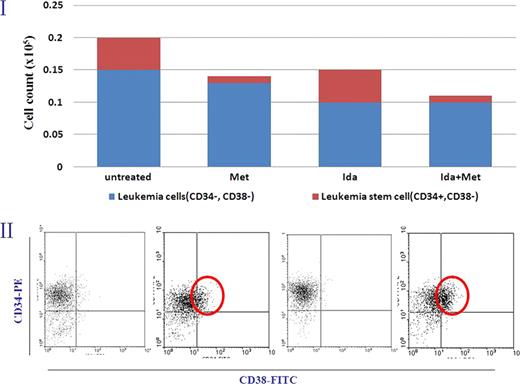Abstract
Abstract 4771
Leukemic stem cell (LSC) has been accused to play a pivotal role in pathogenesis of hematological malignancy such as acute myeloblastic leukemia (AML). AML stem cell (ASC) is known as CD34+CD38– leukemic cell population. Yet, despite their critical importance, much remains to be learned about selectively targeting ASC. Recently metformin selectively targets breast cancer stem cells, and acts together with chemotherapy to block tumor growth. Thus, the current study investigated whether metformin selectively inhibits AML cells and AML stem cells directly or indirectly.
ASC showing CD34+CD38– phenotype were selectively sorted from primary bulk AML cells and KG-1 AML cell lines using single cell sorter (BD FACS Aria cell sorter, BD Biosciences, USA). ASC from primary AML samples and cell lines were cultured in serum media with each 100 ng/mL of stem cell factor, Flt-3, thrombopoietin and G-CSF. Metformin (1,1-dimethylbiguanide hydrochloride) and idarubicin (IDA) were dissolved and diluted with high purity distilled water in various concentrations (0.1 mmol/L to 30 mmol/L). Morphological change, cell count, viability and apoptosis using annexin V flowcytometry were checked after treatment of metformin and IDA. Phosphorylation of AMPK was assayed by western blotting and mitochondrial membrane potential was measured using MitoTracker green dye.
The frequency and proportion of ASC varied according to FAB subtypes. The mean proportion of ASC from AML M2, M4 and M3 showed 25.1±22.5% (mean±SD), 15.1±16.6% and 6.5±3.3%, respectively. The mean proportion of ASC from KG-1 cell lines was 78.6±6.2%. Total cell count of ASC was gradually decreased after treatment of metformin in dose-time dependent manner. Overall viability of AML cell lines and ASC disclosed significant decrease after treatment of metformin. The proportion of apoptosis was increased in time and dose dependent manner after 24-hr treatment of metformin. Mitochondrial membrane potentials were increased after metformin exposure at dose dependent manner. Moreover, when combined with lower concentration of IDA, more profound selective killing effect on AML cell lines and ASC was observed. Western blot analysis showed that the treatment of AML cell lines and ASC with 30 mmol/L of metformin resulting in the increased phosphorylation of AMP-activated protein kinase (AMPK) at approximately 1.5-fold over total AMPK.
Metformin selectively kills AML cells as well as AML stem cells, and acts together with chemotherapeutic drugs to eradicate leukemic cells and their stem cells.
Metformin (Met) inhibits AML stem cells (CD34+CD38-) in KG-1 cell line. Met selectively targets AML stem cells to eradicate leukemic stem cell. Combination of Met with idarubicin (Ida) kills both AML stem cells and leukemia cells (I, histogram; II, flowcytometry scatter plots).
Metformin (Met) inhibits AML stem cells (CD34+CD38-) in KG-1 cell line. Met selectively targets AML stem cells to eradicate leukemic stem cell. Combination of Met with idarubicin (Ida) kills both AML stem cells and leukemia cells (I, histogram; II, flowcytometry scatter plots).
No relevant conflicts of interest to declare.
Author notes
Asterisk with author names denotes non-ASH members.


This feature is available to Subscribers Only
Sign In or Create an Account Close Modal